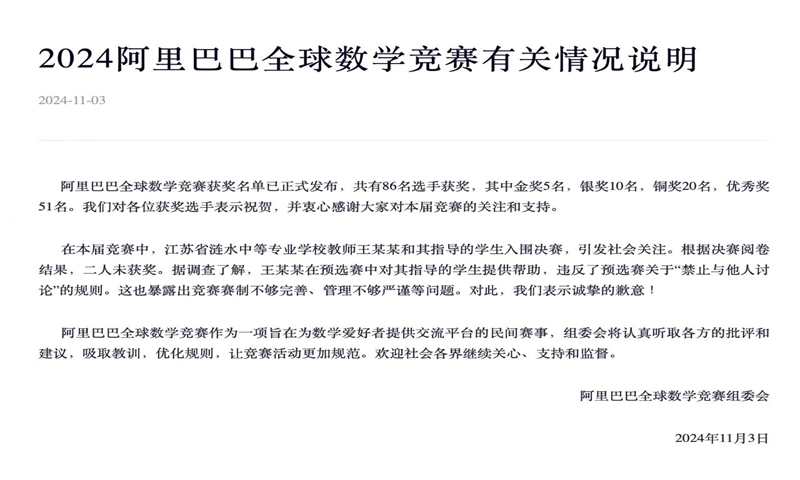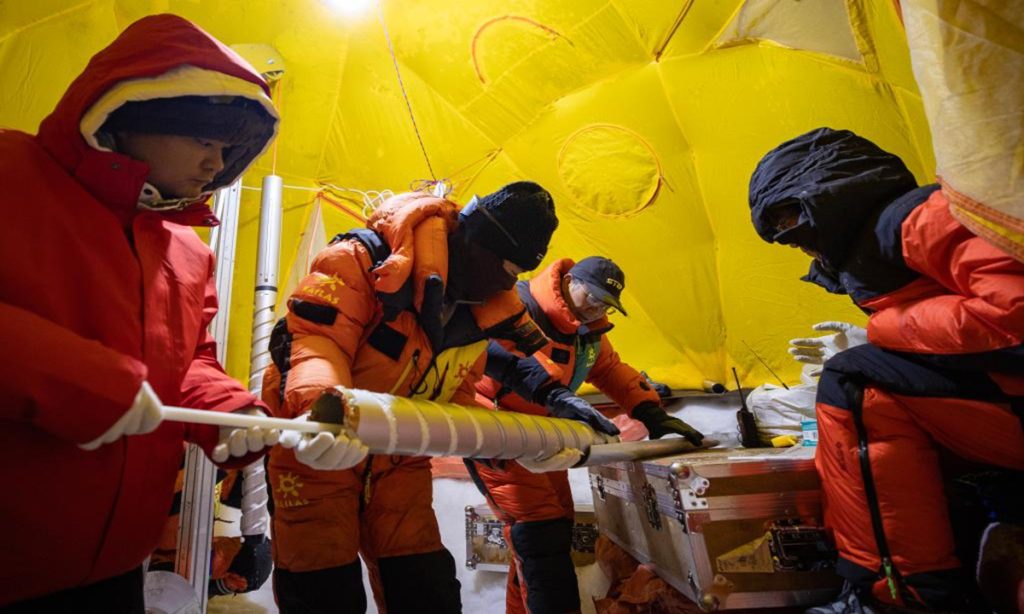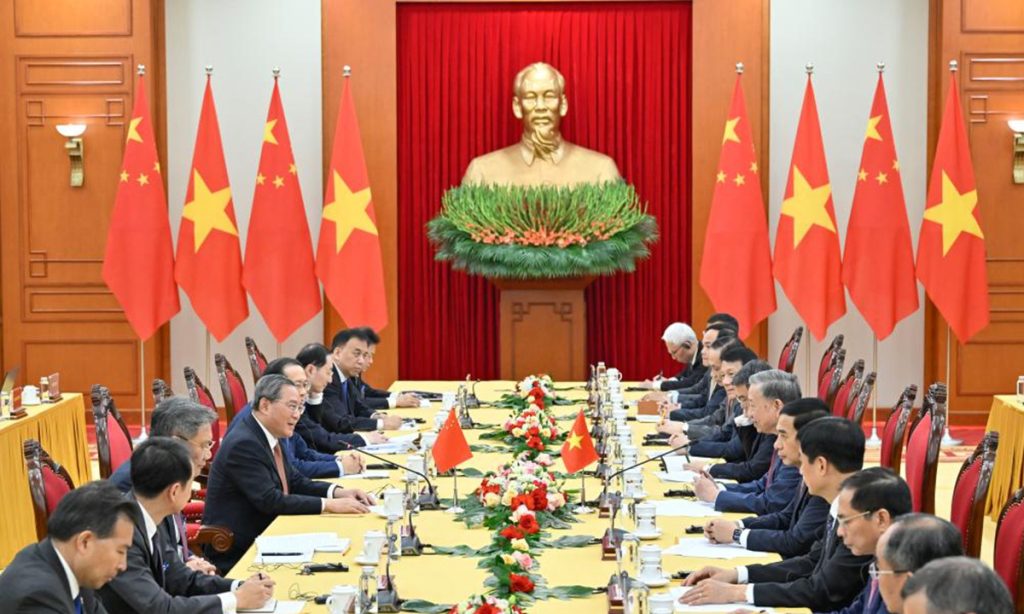Xi holds talks with Italian president
Chinese President Xi Jinping held talks with Italian President Sergio Mattarella in Beijing on Friday.
Chinese President Xi Jinping held talks with Italian President Sergio Mattarella in Beijing on Friday.
Xi sends congratulatory letter to inaugural World Conference of Classics

A four-legged robot recently made its debut as a marathon pacesetter at an international tournament in Hangzhou, East China's Zhejiang Province, capturing public attention and curiosity, according to a report by China Central Television (CCTV) on Monday.
A total of two four-legged robots and one humanoid robot were showcased during the 2024 Hangzhou Marathon on Sunday, which is one of the longest-established running events in China, according to the Xinhua News Agency.
One of the two quadruped robots, B2, took on the role of pacesetter for the final stage of the half marathon, while the other one, Go2, ran alongside the participants in the race, according to a statement sent to the Global Times by Unitree Robotics, a Hangzhou-based civilian robotics company presenting these unveiled robots.
B2 has exceptional endurance and load capacity, an employee from Unitree said. It features a combined operating range of up to 4-6 hours, a sustained walking load of 40-50 kilograms and a maximum standing load capacity of 120 kilograms. To ensure that B2 could perform its duties safely and successfully, tech assistants had conducted nearly 10 on-road tests before the race, said the company, examining human interference, obstacle avoidance and hill-climbing ability across the half marathon route.
The four-legged Go2 robot looks like a rabbit and is capable of performing actions such as making a hand heart, shaking hands, performing backflips and handstands. It can also run while playing music, delivering cheering messages and safety tips, providing runners with packed motivation and emotional value, and encouraging more runners to finish the race.
Many netizens commented that these robots deliver lots of emotional value. A father who attended the race with his child said that the robots brought fun to the track, "(without the robots) children would have become bored and restless. My child enjoyed watching the robots," he said, as reported by CCTV.
"I followed the B2 for the entire race, and it is quite high-tech," a participant named Liu Chang, who participated specifically for the advanced robot, told the CCTV.
In addition to the four-legged robots, a humanoid robot was also showcased in this marathon. It is equipped with interactive functions such as waving, handshaking and posing, congratulating the participants on their victories by making broadcasts, the Global Times learned from Unitree.

The organizing committee of Alibaba Global Mathematics Competition released a statement on Sunday regarding the 2024 competition. In addition to announcing that a total of 86 participants receiving awards, the statement said in this competition, a teacher surnamed Wang from Lianshui Secondary Vocational School in Jiangsu province provided assistance to a student instructed by him during the preliminary round, which violated the "no discussion" rule set for the preliminary. The committee also expressed apologies for the incident.
The statement said that Wang and the student he instructed entered finals, sparking public attention. According the results of the final evaluation, neither of them won an award, the statement said.
The news that a Chinese vocational school student entered the finals of Alibaba Global Mathematics Competition while most finalists are from prestigious institutions such as Peking University, Cambridge or MIT captured wide public attention in June 2024.
The statement said that investigation found that Wang had provided assistance to the student he instructed during the preliminary round, thereby violating the competition's "no discussion" rule.
The incident also exposed issues such as competition system is not well-developed and management not rigorous enough. "In response, we sincerely apologize for this," the statement said.
On the same day, Lianshui Secondary Vocational School in Jiangsu province, where Wang worked, also issued a statement on its official account addressing the incident, which said it is learned that in the 2024 Alibaba Global Mathematics Competition preliminary round, teacher Wang from their school provided assistance to the student he instructed, violating the competition's "no discussion" rule.
Following a review, the school gave Wang a warning and revoked his eligibility for this year's awards and honors. The school indicated that it will further strengthen teacher ethics, school spirit, and academic atmosphere guiding teachers and students to establish correct values and views on success. At the same time, the school appeals to the public to give more tolerance and care for minors.

Chinese scientists have successfully extracted a 324-meter ice core with domestically-made drilling equipment in Purog Kangri Glacier in Tsonyi, China's highest-altitude county, averaging over 5,000 meters above sea level in Xizang Autonomous Region, setting the record for the longest ice core drilled from a glacier in the world's mid- to low-latitudes, the Institute of Tibetan Plateau Research (ITP) under the Chinese Academy of Sciences (CAS) told media outlets on Wednesday.
The previous record, set in 1992, was held by the Guliya Ice Cap in Xizang's Ngari Prefecture on the Qinghai-Xizang Plateau, which was the longest ice core ever drilled on the plateau and the longest outside polar regions globally. Scientists from China and US drilled a 308.6-meter ice core, spanning more than 700,000 years, said Xinhua.
The scientifically rewarding research was achieved thanks to a team led by Xu Baiqing, a deputy director of the ITP, after more than a month's effort at the top operating point of Glacier.
Xu said that the longest ice core on the plateau is characterized by unique geographic and climatic features, capturing historical changes in the region, including vital climate indicators like temperatures and precipitation, as well as environmental incidents like volcanic eruptions and atmospheric pollution, which offer both valuable data and samples for studying the patterns, mechanisms, and potential future trends of global climate change, and for predicting future trends.
Drilling and preserving ice cores allows us to understand changes in climatic conditions by obtaining valuable historical data, Xu added.
Yao Tandong, an academician of the CAS, said that by measuring the thickness and extracting ice cores, scientists have the opportunity to better examine both recorded and current environmental changes in the largest ice field in low- to mid-latitude regions, fostering a deeper understanding of global warming's effects on glaciers.
According to Xinhua, the Purog Kangri Glacier scientific research project represents a key component of a scientific expedition launched in Lhasa in August 2024, which aims to propose critical measures for ecological protection and restoration, along with scientific recommendations for green development.
The Global Times learned from ITP earlier in September that a team led by Chinese academician Fang Xiaomin from the ITP, also engaged in this expedition, set a new record of 750 meters in environmental science drilling in the Qinghai-Xizang Plateau.
This research offers scientists a detailed record of the uplift of the central Tibetan Plateau and the historical changes in climate and ecological environment, and making it one of the primary areas for studying the co-evolution of tectonics, climate, biology and ecology.
Chinese President Xi Jinping met Tuesday with his Russian counterpart, Vladimir Putin.
Xi arrived in Kazan earlier in the day for the 16th BRICS Summit.

"Civil-military dual-use goods, technologies, and services that, if misused after export, could endanger national security and affect world peace and security. Dual-use items export control measures are in line with international norms," He Yadong, a spokesperson for China's Ministry of Commerce (MOFCOM) said on Thursday.
Regarding a question on dual-use items, He clarified that dual-use items mean goods, technologies and services that may be used either for civil purposes or for military purposes or to contribute to an increase in military potential, especially to design, develop, produce or use weapons of mass destruction and their means of delivery.
"The introduction of the Regulations of the People's Republic of China on Export Control of dual-use items is a refinement of China's Export Control Law. The regulations are an important measure to improve the export control system and enhance legal governance in export control of dual-use items. The transparency and standardization of export control policies for dual-use items will be enhanced," He noted.
A State Council decree unveiling the regulations on export control of dual-use items was signed in September, according to a notice published by the State Council on October 19. The dual-use items export control regulations will take effect on December 1, 2024.
"For more details on the background, approach, and key provisions of the regulations on the export control of dual-use items, please refer to the answers provided by officials from the Ministry of Justice (MOJ) and the MOFCOM to journalists' questions, which are available on official websites," said He.
On Saturday, the MOJ and the Ministry of Commerce stressed that export controls are not a prohibition on exports. Dual-use items export control measures are in line with international norms, and they will help ensure trade security while promoting the normal trade of dual-use items.
The regulations will not pose obstacles to normal international scientific and technological exchanges and economic and trade cooperation, or disrupt the smooth operation of global industrial and supply chains, the two ministries said.
The regulations also include detailed measures for license management, control list and supervision of export control of dual-use items, according to the Xinhua News Agency.

The autumn harvest is currently in full swing across China, the largest food producer and third largest food exporter in the world.
Autumn grain is the main component of annual grain production, accounting for about three-quarters of the total grain output for the year. It is crucial for securing the Chinese people's "rice bowl."
Bustling farmers can be seen in fields across the nation, promising a fruitful year during the golden days of October. In East China's Jiangsu Province, autumn grain area exceeds 44.7 million mu (2.98 million hectares), continuing to increase compared to the previous year; In Northwest China's Xinjiang Uygur Autonomous Region, cotton harvesting has also kicked off. According to the latest report, the overall cotton yield in Xinjiang this year will increase by five percent to 10 percent compared to last year; In Southwest China's Sichuan, the harvesting of 28 million mu of rice and 22 million mu of spring corn is nearing completion.
In total, more than 64 percent of the autumn food crops in China have been harvested, reflecting a pace that is 1.1 percentage points faster than anticipated, the Chinese Ministry of Agriculture and Rural Affairs said on Tuesday.
The importance of food security for the development and happiness of people's lives was reiterated on World Food Day, which fell on Wednesday.
The theme of this year's World Food Day is "Right to foods for a better life and a better future." It aligns with China's consistent emphasis on food security as the country feeds over 1.4 billion people with only nine percent of the world's arable land. Food security is listed as one of the eight priority areas of cooperation in China-propopsed Global Development Initiative.
An array of measures have been implemented to improve grain output over the past few years, including building more high-standard farmland and promoting agricultural technology, according to the Xinhua News Agency.
High-standard farmland is characterized by well-leveled, contiguous plots with advanced irrigation, efficient water use and enhanced soil fertility. Designed to withstand both droughts and floods, it aligns with modern agricultural practices and features pollution-free soil and high yields, according to Xinhua.
According to a report submitted to a legislative session in September, China had developed over 1 billion mu (about 66.7 million hectares) of high-standard farmland by the end of 2023, with 13 key grain-producing provincial-level regions accounting for around 70 percent of the total, Xinhua reported.
In recent years, the country has also been providing emergency food assistance to countries suffering from natural disasters and humanitarian crises, and actively sharing agricultural know-how and technology to help developing countries enhance food production, Mao Ning, spokesperson of the Chinese Foreign Ministry, noted at a press conference on Wednesday.
China stands ready to work with all sides to enhance food security cooperation and strive for a world free of hunger, Mao said.

Chinese social media has emerged as a new arena for some Australian politicians to gain more popularity in the ongoing council elections in Melbourne.
After Victorian Electoral Commission sending people who are enrolled to vote a ballot pack in early October, voters are expected to post back their completed ballot papers by October 25, according to Melbourne’s government website.
Multiple mayoral candidates are going all out to win the support of the significant Chinese population by distributing bilingual campaign flyers in both Chinese and English, actively participating in various Chinese community events and even leveraging Chinese social media platforms to share their campaign visions and connect with the electorate.
Enthusiastic interaction
Unlike in state and federal elections, many non-Australian citizens who meet certain requirements are eligible to vote in the Melbourne City Council elections. The electorate includes international students, anyone on a working holiday visa, those who own a property in the city and live in it, and business owners, according to Australian media outlet ABC News.
To connect with one of the city’s most significant demographic groups, current Lord Mayor Nick Reece and challenger Arron Wood have both opened accounts on Little Red Book, or Xiaohongshu, a popular Chinese social media platform.
In an exclusive interview with the Global Times, Reece explained his motivation for joining Xiaohongshu. “As Lord Mayor of Melbourne, it is vital to connect with all communities in the city, and the Chinese community is a significant part of Melbourne’s cultural and social fabric,” he stated.
Since opening his account, Reece has shared dozens of videos and posts, amassing a following of over ten thousand users who expressed their eager to engage with his vision for the city. Some of his posts feature recommendations for local food, restaurants, and a great spot to play basketball in Melbourne.
Reece shared with the Global Times a touching moment, explaining how a Chinese student expressed gratitude for the support provided to international students studying in Melbourne during difficult times.
On the other hand, Wood has also made his marks on Xiaohongshu, expressing his belief that Melbourne has lost its way under the current administration.
“Melbourne is a great city, but there’s no doubt our city has gone backwards over the past four years, under the leadership of Reece... It’s clear we need new leadership... It’s time for action, not more empty promises,” Wood said in an exclusive reply to the Global Times.
“The success of Melbourne depends on the strength of its diverse communities, and the Chinese community has contributed so much to Melbourne over so many years... Whether it’s the historic Chinatown or the many Chinese businesses that boost our local economy, their influence is felt everywhere,” he said.
Both candidates have laid out ambitious plans for their potential terms in office, particularly concerning the Chinese community. Reece aims to enhance language accessibility in public services, support Chinese businesses and strengthen cultural exchange programs. He said he is particularly proud to have the oldest Chinatown in the city and is committed to ensuring it remains a bustling precinct just as it was 170 years ago. Also, he promised to ensure strong Chinese Australian voices to be part of his council team.
Wood has also introduced initiatives including tackling the cost-of-living crisis, enhancing city safety and cleanliness, and promoting cultural diversity. Wood vows to expand the free tram zone to make transportation more affordable for all, and provide greater support to small business owners, many of whom are vital to the economic and cultural fabric of Melbourne’s Chinese community.
Their presence on the Chinese social media has gained floods of enthusiastic feedback from Chinese netizens. A Xiaohongshu user based in Melbourne shared flyers of multiple candidates that are printed in Chinese, and said the Chinese community is becoming stronger.
Many Xiaohongshu users also left suggestions regarding how to build a better Melbourne. For example, an international student who is about to complete her undergraduate studies in Melbourne highlighted safety concerns, and hopes that more security measures in the city will be implemented.
Vital Chinese community
With a rich tapestry of culture and a growing population, Chinese voters represent a vital demographic in the city’s electoral landscape.
Data by the State Government of Victoria shows that the Chinese community in Victoria is the second largest in Australia. There are 427,811 people in Victoria who have Chinese heritage, of which 171,447 were born in China. Among them, Melbourne, the capital of Victoria, has the third largest Chinese community, with 34,469 people.
With the recent improvement in China-Australia relations, many Australian politicians are eager to cultivate a positive image among the Chinese populace in and outside Australia, said Chen Hong, executive director of Asia Pacific Studies Center at East China Normal University.
It is encouraging to see more politicians in Australia adopting a rational and pragmatic approach to their exchanges with China, Chen said. “This stands in stark contrast to anti-China political figures in certain countries that frequently smear Chinese social media platforms,” he said.
He believes the ongoing people-to-people exchanges can significantly contribute to the overall warming and improvement of relations between the two countries.

China stands ready to promote high-quality and high-level cooperation in various fields with Vietnam and is willing to continue to make bigger the pie of economic and trade cooperation, said Chinese Premier Li Qiang who is on a three-day official visit to Vietnam.
When meeting with To Lam, general secretary of the Communist Party of Vietnam Central Committee and Vietnamese president, on Saturday, Li conveyed the cordial greetings of Xi Jinping, general secretary of the Communist Party of China Central Committee and Chinese president, to To Lam, saying that in August this year, the top leaders of the two parties and countries held a meeting in Beijing and made a strategic plan for promoting the building of a China-Vietnam community with a shared future, which charted the course for the development of bilateral relations, according to the Xinhua News Agency on Sunday.
With the political guidance of top leaders from both nations, frequent high-level interactions have deepened political trust, promoting long-term, stable, and healthy development of bilateral relations and pushing them to a higher level. This will also inject greater momentum into economic, social, and civil exchanges and cooperation between the two nations, observers hailed on Sunday.
Frequent, high-level, and high-quality interactions underscore the significance both sides place on their amicable relations, Gu Xiaosong, dean of the ASEAN Research Institute of Hainan Tropical Ocean University, told the Global Times on Sunday.
Concrete actions
Li pointed out that China stands ready to solidify the six major goals of greater political mutual trust, more substantive security cooperation, deeper practical cooperation, more solid popular foundation, closer multilateral coordination and collaboration, and more proper management of differences, Xinhua reported.
Li expressed hope that the two sides will simultaneously promote the "hard connectivity" of railway, expressway and port infrastructure and the "soft connectivity" of smart customs to provide solid support for improving the facilitation of trade and investment and safeguarding the stability and smooth flow of industrial and supply chains.
Li also said China is willing to actively study the pilot construction of cross-border economic cooperation zones, expand cooperation in emerging fields such as information technology, new energy, digital economy, and important minerals, and deepen cultural exchanges.
China stands ready to carry out cooperation under the three major global initiatives, jointly promote the building of an equal and orderly multipolar world and a universally beneficial and inclusive economic globalization, and maintain and promote prosperity and tranquility in Asia, Li said.
Cooperation in infrastructure development is a key and exemplary sector of China-Vietnam collaboration. In addition to directly driving the development of border regions and ports on both sides, it creates positive spillover effects in markets and investment, boosting the creation of a China-Vietnam community with a shared future, Ding Duo, a deputy director of the Institute of Maritime Law and Policy at China's National Institute for South China Sea Studies, told the Global Times on Sunday.
Both countries continue to strengthen bilateral relations through concrete actions, particularly in areas such as trade cooperation and regional connectivity. The construction of a cross-border railway, for instance, will enhance cooperation between China and Southeast Asia, Gu said.
China is the biggest trading partner of the Vietnam, with the bilateral trade exceeding $200 billion for three years in a row, and reaching $145.07 billion from January to July in 2024, a year-on-year increase of 20.9 percent, according to China's Ministry of Commerce.
For his part, To Lam asked Li to convey his sincere greetings to Xi, and warmly congratulated the 75th anniversary of the founding of the People's Republic of China.
The Vietnamese side will firmly follow the path jointly set by the top leaders of the two parties and the two countries, adhere to the six major goals, deepen the Vietnam-China comprehensive strategic cooperative partnership, and promote the building of a Vietnam-China community with a shared future that carries strategic significance.
He noted that Vietnam firmly abides by the one-China principle and firmly opposes all forms of "Taiwan independence" separatist activities.
Vietnam is the second stop of Li's ongoing Asia tour. Prior to this, he visited Laos, where he participated in a series of leaders' meetings on East Asia cooperation and conducted an official visit to the country, according to Xinhua.
According to the Vietnamese government website, Prime Minister Pham Minh Chinh hosted an official welcome ceremony for Chinese Premier Li Qiang at the Presidential Palace in Hanoi on Sunday.
In his meeting with Vietnamese Prime Minister, Li urged both sides to stick to friendly consultation, properly handle differences and expand maritime cooperation. In response, Pham Minh Chinh said the two sides should implement the high-level consensus of the two parties and two countries, properly manage differences through friendly consultation, and jointly safeguard maritime peace and stability.
Vietnam and China signed 10 agreements ranging from agriculture cooperation to cross-border QR code payments on Sunday, according to Vietnamese government website. The two countries also signed a document on updating progress on cross-border railway links related to site survey. The signing ceremony followed Li's meeting with Vietnamese Prime Minister Pham Minh Chinh.